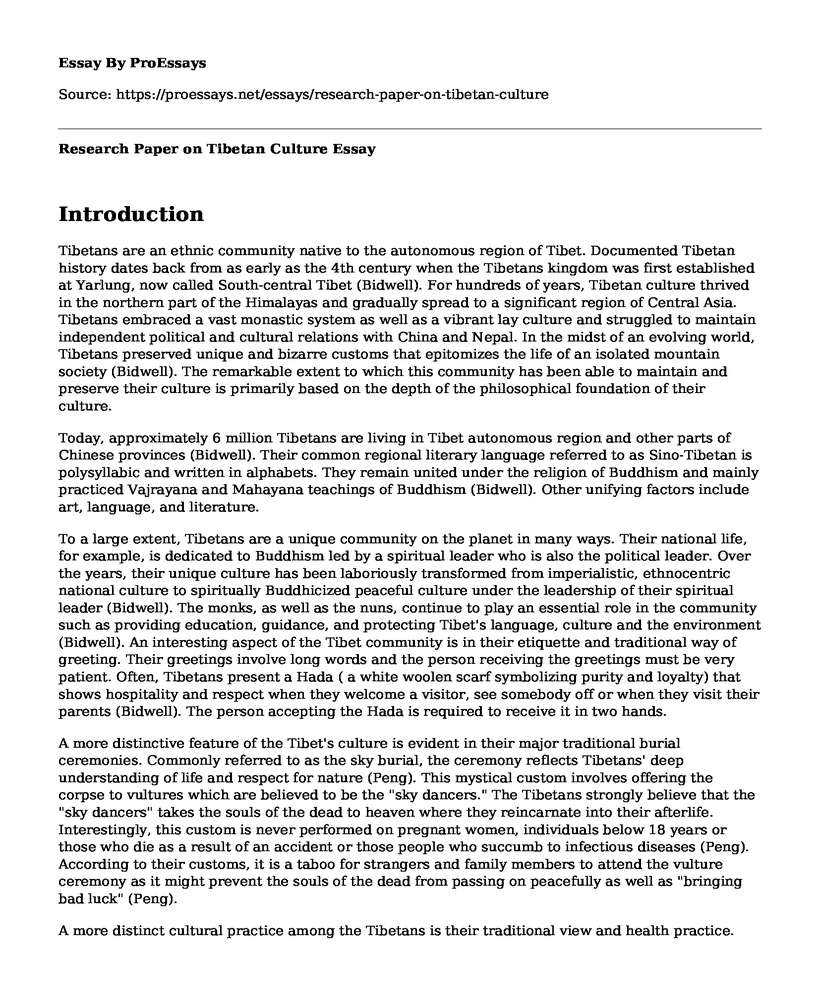Introduction
Tibetans are an ethnic community native to the autonomous region of Tibet. Documented Tibetan history dates back from as early as the 4th century when the Tibetans kingdom was first established at Yarlung, now called South-central Tibet (Bidwell). For hundreds of years, Tibetan culture thrived in the northern part of the Himalayas and gradually spread to a significant region of Central Asia. Tibetans embraced a vast monastic system as well as a vibrant lay culture and struggled to maintain independent political and cultural relations with China and Nepal. In the midst of an evolving world, Tibetans preserved unique and bizarre customs that epitomizes the life of an isolated mountain society (Bidwell). The remarkable extent to which this community has been able to maintain and preserve their culture is primarily based on the depth of the philosophical foundation of their culture.
Today, approximately 6 million Tibetans are living in Tibet autonomous region and other parts of Chinese provinces (Bidwell). Their common regional literary language referred to as Sino-Tibetan is polysyllabic and written in alphabets. They remain united under the religion of Buddhism and mainly practiced Vajrayana and Mahayana teachings of Buddhism (Bidwell). Other unifying factors include art, language, and literature.
To a large extent, Tibetans are a unique community on the planet in many ways. Their national life, for example, is dedicated to Buddhism led by a spiritual leader who is also the political leader. Over the years, their unique culture has been laboriously transformed from imperialistic, ethnocentric national culture to spiritually Buddhicized peaceful culture under the leadership of their spiritual leader (Bidwell). The monks, as well as the nuns, continue to play an essential role in the community such as providing education, guidance, and protecting Tibet's language, culture and the environment (Bidwell). An interesting aspect of the Tibet community is in their etiquette and traditional way of greeting. Their greetings involve long words and the person receiving the greetings must be very patient. Often, Tibetans present a Hada ( a white woolen scarf symbolizing purity and loyalty) that shows hospitality and respect when they welcome a visitor, see somebody off or when they visit their parents (Bidwell). The person accepting the Hada is required to receive it in two hands.
A more distinctive feature of the Tibet's culture is evident in their major traditional burial ceremonies. Commonly referred to as the sky burial, the ceremony reflects Tibetans' deep understanding of life and respect for nature (Peng). This mystical custom involves offering the corpse to vultures which are believed to be the "sky dancers." The Tibetans strongly believe that the "sky dancers" takes the souls of the dead to heaven where they reincarnate into their afterlife. Interestingly, this custom is never performed on pregnant women, individuals below 18 years or those who die as a result of an accident or those people who succumb to infectious diseases (Peng). According to their customs, it is a taboo for strangers and family members to attend the vulture ceremony as it might prevent the souls of the dead from passing on peacefully as well as "bringing bad luck" (Peng).
A more distinct cultural practice among the Tibetans is their traditional view and health practice. Tibetan medicine remains an integral part of their culture in a world dominated by western medicine. It is a practice that is deeply rooted on philosophical teachings of Buddhist faith and focuses on a balance between the body and mind as well as a balance between the organism and the entire universe (Peng). Precisely, Tibetan medicine functions to restore cosmic equilibrium between the universe and the organism through curative and preventative efforts. In contrast to modern medicine, Tibetan Buddhist tradition considers ignorance as the primary cause of diseases. According to their beliefs, ignorance leads to hatred, aversion, and desire which poison the body by stimulation the bile humor, wind humor and the phlegm humor (Peng). Disruption of these humor upsets the balance hence causing a disease. The healing process involves Tantric, somatic and Dharma medicine administered at different levels. Tantric medicine (yoga) covers the mind and body while Dharma medicine attempts to heal through spiritual and psychological practices. Somatic medicine, on the other hand, incorporates "the practice of Indian Ayurveda" in the healing process (Peng). Also, it is a common cultural belief that the teachings of Buddha can help restore the balance of the body. In general, Tibetan medicine functions cohesively to restore overall body health through a harmonized mind and body.
Works Cited
Bidwell, Kate. "Tibetan Medicine." Home.wlu.edu. N.p., 2013. Web. 20 Mar. 2018.
Peng, Jia. "An Exploration of Tibetan Tantric Buddhism and Its Art: A Potential Resource For Contemporary Spiritual And Art Practice." Discovery.ucl.ac.uk. N.p., 2015. Web. 20 Mar. 2018.
Cite this page
Research Paper on Tibetan Culture. (2022, Apr 04). Retrieved from https://proessays.net/essays/research-paper-on-tibetan-culture
If you are the original author of this essay and no longer wish to have it published on the ProEssays website, please click below to request its removal:
- Article Review About Taiwanese Community
- Genealogy Essay Example
- How Culture and Tradition Influence Choices Essay
- Management Administration: Event Planning Manager Paper Example
- A Story From a Non-Western Culture
- Paper Example on Lower Health Care Costs: A Necessity for Family Wellbeing
- Essay Example on US Internment of Japanese Americans: Fred Korematsu's Story







